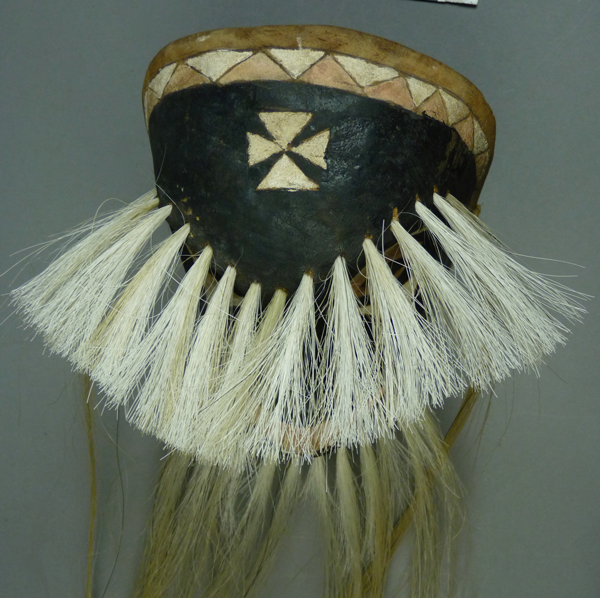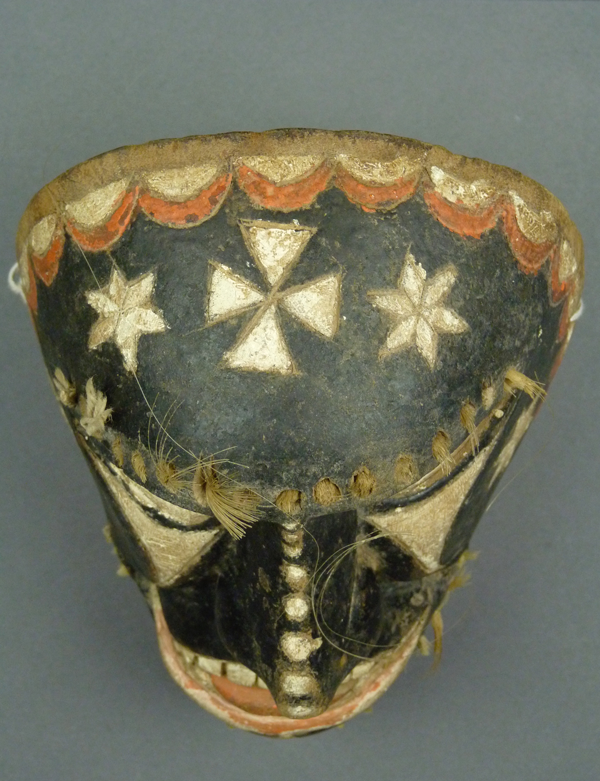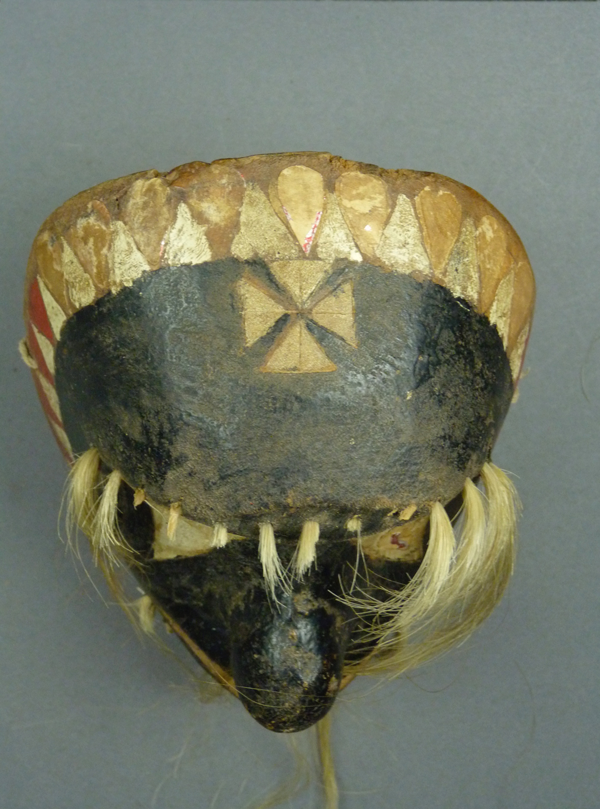This series of posts about Yoeme (Yaqui) Pascola masks began on July 4, 2016. Last week I introduced you to one of the greatest Yoeme carvers—Manuel Centella Escalante of Potam, Sonora. Because my first mask by Centella had a Chango (monkey or ape) face, I started with six or maybe seven of his Chango masks. Today I will move on to a number of his human faced masks, which display many of the same design details that you had encountered on the Chango masks. My first human faced mask by Manuel Centella has a remarkable history, according to Tom Kolaz.
To begin with, this was one of a number of Pascola masks carved by Centella that had been owned and danced by Lino Suarez, the Pascola Mayor (lead Pascola dancer) at Old Pascua ( in Tucson). In Old Men of the Fiesta: An Introduction to the Pascola Arts (by James Griffith and Felipe Molina, 1980, page 31) there is a photo of Lino Suarez that was taken in 1939; Rosario Castillo, the grandfather of Felipe Molina, is standing next to Lino in the photo. Unfortunately the photo does not reveal their masks in any detail. Lino later died, and for some period of time his house was not occupied. It fell into disrepair, and there was a plan for it to be demolished. Just before the bulldozer arrived, some Yaquis discovered that Lino’s collection of Pascola masks (all by Centella) were still hanging on the walls. These were rescued, sold to a Tucson dealer, and in 1993 I purchased two of them, a human faced mask and another depicting a goat. The two were weathered and each had lost its hair. Tom Kolaz, who had played an important role in their rescue, although he was not their purchaser, later arranged on my behalf for those two masks to be re-haired by a Tucson mask maker, David Valenzuela. In a future post I will show the Goat Pascola mask from Lino’s house, but here is that human faced mask.
Centella’s characteristic crosses, composed of four triangles with their points together, are apparent on the forehead and chin. The hair bundles were restored by David Valenzuela using horse tail.
From the side, one sees one of Centella’s most characteristic rim designs. Also note the inscribed and painted triangles over the eyes that mirror those below. Centella alone included this detail consistently, although his contemporary, Inez “Cheto” Álvarez, sometimes copied this detail. Finally, this photo provides an excellent view of Centella’s preference for oversized noses; these are actually caricatures of ordinary noses.
Tom Kolaz pointed out to me that one distinguishing feature of Centella’s masks is his tendency to install many hair bundles for the brow and beard. We saw this characteristic as well on the masks of Alejandro Reyes Alegria, who provided as many as 21 hair bundles on the beard of one of the masks (7/18/2016). In the photo above there are 15 bundles across the brow, while the following photo reveals 13 bundles in the beard.
Painted dots down the nasal ridge are another typical Centella touch. Note again that Centella usually provides a chin cross, outlined by inscribed lines. This mask is 7¾ inches tall, 5½ inches wide, and 3½ inches deep.
The back of this mask demonstrates significant staining from use—differential staining—with “sweat varnish” around the inside of the rim versus a visibly less stained central area between the eyes and the mouth. It is clear that Lino Suarez danced wearing this mask.
I purchased my second human faced Pascola mask by Manuel Centella from Spencer Throckmorton III, a Manhattan ethnographic and related arts dealer, in 1993. There was no identified carver, but the masks you have seen already should permit you to immediately identify this mask as Centella’s. As a matter of fact, this is one of the best masks by this carver that I have ever seen. Then again, I discovered others that are also wonderful when I photographed the Barney Burns and Mahina Drees collection; you will see some of those later in this post.
Some of the elegant details of this mask will be familiar, such as the oversized nose, the rim design, the dotted nasal ridge, and the crosses on the forehead and chin. However the artist has substituted a graceful curling line over the eye and a trail of three small triangles underneath for the usual paired triangles above and below the eyes. Such a variation was intended to mimic the war paint of Plains Indians, so this is an “Apache” mask. Also the shaping of the area around the mouth is particularly striking.
On top of this mask, the usual cross is flanked by segmented six pointed stars that are also characteristic of this carver.
There are four teeth that have been implanted in the mouth. Also note the solitary hair tufts on the cheeks, a feature of older Yaqui masks that Centella often copied.
Centella’s attention to the hair bundles is impressive. This mask is 7 inches tall, 5½ inches wide, and 3 inches deep.
The back of this mask demonstrates differential wear, and the much lighter chipped area underscores the extent of this staining.
Here is the first of three excellent and old human faced masks by Manuel Centella in the Barney Burns and Mahina Drees collection. None of them came with reliable information, having been attributed to other carvers, so I prefer to describe them based on the visual evidence.
This mask greatly resembles the one that preceded it. It has four of the segmented six pointed stars, the dots on the nose, and the usual paired triangles, above and below the eyes. What sets it apart is the mouth.
The side view is most revealing of the magnificence of this mask. Because the hair has been lost (probably eaten by insects), one has the opportunity to see details that would ordinarily be hidden, such as a carved shelf for the application of the hair tufts for the beard.
This mask has the same elegant rim design as the last and the same stars.
On the chin we find the usual cross.
The staining of the back suggests considerable age and use. I would date this mask to the 1960s or earlier.
Here is another that is nearly as good. Again, most of the decorative details are familiar
The inlaid chin cross is sawn from either mother of pearl or from plastic.
I like the inscribed lizards on the temples, and I am most impressed with the hooded eyes that make me think of snakes’ eyes. But the crowning glory of this mask is the nose!
Here is another view of the inlaid chin cross.
The hair on this mask is an unusual color. I guess that it is cow tail.
From the back, we see that this is another mask with great age.
The last of this trio from the Barney and Mahina collection is also wonderful.
From the front, the patina is most impressive; the paint is so dusty and worn.
But from the side, one discovers another terrific nose and this is just part of an impressive profile. This mask has a sawn slit mouth like several of the Chango masks, and I am uncertain whether this is a Chango or a Viejo mask.
Someone has augmented the rim design and the forehead cross by gluing on cut paper shapes.
In contrast, most of the rim design was not altered.
Here is another ancient back.
Next week I will show more of Centella’s human faced masks.


























Pingback: Recent arrivals on the EBay Beach IV | Mexican Dance Masks